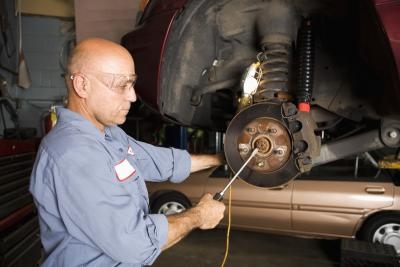
Automobiles offer freedom on the open road, using many intricately connected systems for propelling the vehicle forward. Working alongside the car's wheel assemblies are the wheel hub bearing assemblies. Wheel rotation is impossible without properly aligned and lubricated hub bearings for both the front and rear axles. There are certain symptoms that arise when a rear hub bearing goes bad.
Both rear tires use hub bearings to support the weight of the vehicle's back end. A typical passenger vehicle places 850 lbs. of pressure on each hub bearing. Larger vehicles require even more pressure across the hubs, approximately 1,500 lbs. per hub for a standard 6,000-lb. sport utility vehicle. The hub bearings are part of the vehicle's suspension system, providing a smooth rotation for the attached wheels.
Discovering a bad rear hub bearing usually involves a noise. Bearings use smooth spheres rotating against one another within a tight circular housing. Bad bearings lose smooth rotation and create a growling noise. The noise will not change tone with acceleration or deceleration. However, the noise may diminish during turns. Bearings must be inspected immediately for the overall safety of the driver and others on the road.
It is possible for a vehicle to lose a wheel from a seized rear hub bearing. Ignoring a constant bearing noise can lead to complete seizure of the bearing assembly. The rotating spheres become stuck within their tight assembly due to the accumulation of dirt or lack of lubrication. The rear hub stops rotating completely, resulting in a seizure of the entire wheel and tire assembly. At high speeds, the stuck wheel may actually be forced off the vehicle, causing a potentially dangerous situation.
Newer vehicles have sealed wheel hub bearings. Their sealed assemblies cannot be serviced or repaired. The entire hub assembly must be replaced if any malfunction occurs to the bearings. Many newer vehicles have anti-lock brake sensors affixed to the hub assembly, so replacement of the bearings includes the sensor as well. Older vehicles have serviceable wheel bearings. Typically, the bearings are disassembled and the old lubricating grease is removed. Mechanics pack new grease in the spacings of the bearings for a smooth riding result.
Aside from a growling noise, some bad rear hub bearings are discovered when the vehicle enters a repair center for an alignment or brake job. A technician can tell a bad bearing by holding the car's attached wheel and rocking it up and down. Any play or friction from the bearings behind the wheel signifies that the hub needs to be replaced.